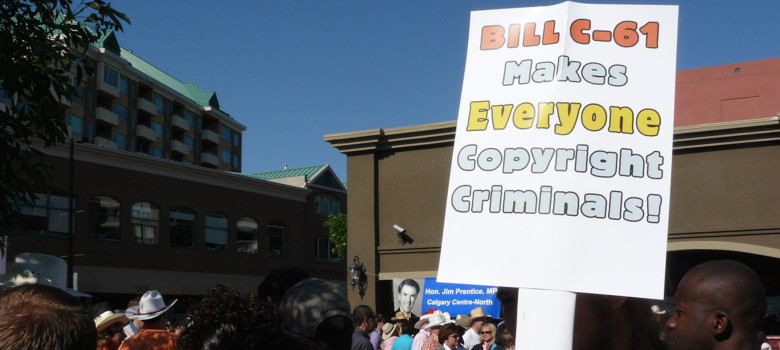In the decade of lobbying leading up to the reform of Canadian copyright law in 2012, copyright lobby groups had one core message: Canada needed to implement and ratify the World Intellectual Property Organization’s Internet treaties. While many education, consumer, and business groups expressed concern that the digital lock rules in the treaties would harm innovation, the industry was insistent that the treaties represented an essential component of digital copyright reform.
My op-ed for the Hill Times notes that the lobbying campaign was successful as Canada proceeded to implement and ratify the treaties. The legislation is still relatively new, but in a stunning reversal, one of the leading lobby groups now says that the drafters of the WIPO Internet Treaties were just guessing and suggests that they guessed wrong.
The intensity of the lobbying for the WIPO Internet treaties is difficult to overstate. For years, the industry emphasized the importance of the treaties as the baseline starting point for reform. But in a speech to the Economic Club of Canada last month, Music Canada President Graham Henderson acknowledged that “the people setting the rules for our world were well-intentioned and clever; but the reality is that they were guessing.”
Henderson proceeded to make the case that the drafters guessed wrong, arguing that “everything would come down to the question of balance” and that “very quickly, fissures began to appear” with benefits to intermediaries and losses to creators. This led Henderson to claim that there is a “value gap”, which he defines as “the gross mismatch between the volume of music being enjoyed by consumers and the revenues being returned to the music community.”
The criticism of the WIPO Internet treaties raises several issues.
It is striking to see Henderson now talk about the need for balance in the treaties since that is exactly what educators, librarians, consumer groups, and many innovative businesses argued in 2010 when the reform bill was introduced. Simply put, there was no balance in the bill’s digital lock provisions, which remain among the most restrictive in the world and badly undermine the traditional copyright balance in the digital world.
While Canadians can freely exercise their fair dealing rights in the analog world, the 2012 reforms went far beyond the WIPO treaty requirements by creating unnecessary restrictions on fair dealing in the digital environment. This creates a “fair dealing gap”, where there is a gross mismatch between user rights in the analog world and the digital world. The fair dealing gap should be addressed in 2017 by establishing a long overdue fair dealing exception for the digital lock rules.
Second, claims that the treaties led to an unfair balance favouring technology companies simply does not apply in Canada (if anywhere). Canada did not implement the U.S. DMCA notice-and-takedown system nor grant safe harbours from liability in 1998. The 2012 Canadian reforms include some safe harbours, but not before the industry received the right to forward an unlimited number of notices to Internet users at no cost through the notice-and-notice rules, a new enabler provision to make it easier to target piracy websites, and the restrictive digital lock rules.
Further, the government also gave the music industry a copyright term extension for sound recordings in 2015 with little public debate or consultation. In other words, claims that “policy-making regarding copyright law continues to be driven by the popular mythology that digital technologies and platforms produce lucrative new opportunities for the creative economy”, as stated by Henderson, is not reflective of the Canadian experience.
Third, unlike the fair dealing gap which is the result of legislative reform, the so-called “value gap” has nothing to do with legislative change. Industry frustration with payments for streaming services are not a function of the law, but rather based on revenue sharing from advertising.
Some may wish to paint the Canadian and U.S. digital copyright experiences as the same, but the reality is that they are very different. Canada did not enact the U.S. rules in 1998. Rather, it ultimately gave the industry what it asked for, implementing and ratifying the WIPO Internet treaties in an overly restrictive manner that created a fair dealing gap that persists to this day.
If Canada is to re-examine the decision to ratify those treaties on the basis that it was all just a wrong guess, the starting point would be to fix the imbalance on fair dealing in the analog and digital worlds that has undermined Canadian innovation and the commitment to balance found in copyright law.








Pingback: Canadian Copyright Reform Requires Fix to the Fair Dealing Gap – WP RSS Aggregator Advanced Demo
EXCELLENT rebuttal of Mr Henderson’s pretenses. I am so glad you are here to give a voice to the majority who would love to be heard but doesn’t have your eloquence to do so against the special interests with their seemingly unlimited lobby who are relentlessly chipping away at our rights!
The copyright industry reminds me of the abusive husband, and the internet is their wife. They have a real and important problem, but are unable to see that their response to it is completely insane and aimed at the wrong target. Given their track record, I am not sure that rehabilitation of the copyright industry is possible.
You can’t rehabilitate or repurpose copyright. It has outlived its original purpose long ago, and cannot be applied reasonably to the present.
Pingback: Canadian DMCA in Action: Court Issues Massive Damage Award in First Major Anti-Circumvention Copyright Ruling - Michael Geist